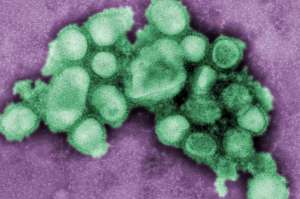 The swine flu virus, up close (and colorized!)
The swine flu virus, up close (and colorized!)
Credit: C. S. Goldsmith and A. Balish, CDC
Swine Flu has been blanketing the news as of late. On April 29th, the Centers for Disease Control and Prevention (CDC) reported the first US fatality occurring in Texas. The CDC has determined that this swine influenza A(H1N1) virus is contagious and spreading from human to human. Yet at this time, they do not know how easily the virus spreads between people. At our museum, we have taken this very seriously and staff has been asked to stay home if symptoms arise.
CDC is recommending that those who come down with flu-like symptoms stay home from work in order to decrease the rate of infection. The Swine Flu is a viral infection rather than a bacterial infection, which makes it harder to treat. Much of the care for viruses is preventive; viruses are hard to treat after they have entered a living host.
Many people do not know the difference between a viral infection and a bacterial one and consider them interchangeable. Yet they are quite different. Viruses are sub-microscopic particles ranging in size from 20 to 300 nanometers (about 1000 times smaller than the width of a human hair). Viruses must have a living host to function. They remain dormant until they infect a living cell. Within a cell, they then change the genetic material of the cell to replicate the virus. AIDS and Influenza are both created by this process of taking over the normal function of a cell in order to replicate viral cells.
Bacteria do not take over cells. Bacteria are much larger than viruses, usually 10 to 100 times bigger than a virus. Their shapes include curved rods, spheres, rods and spirals. They are known as intercellular organisms because they live between cells. All viruses are harmful to the host because they alter cells, but bacteria can be beneficial (like the species that live in our guts and help us digest our food).
